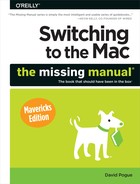For word nerds everywhere, the Dictionary (and thesaurus) is a blessing—a handy way to look up word definitions, pronunciations, and synonyms (Figure 18-11). To be precise, OS X comes with electronic versions of multiple reference works in one:
The entire New Oxford American Dictionary. The third edition, actually. You’ll note that its entries give you more examples, background, and tables that help to differentiate fine shades of meaning (look up weak for an example).
The complete Oxford American Writer’s Thesaurus.
Two venerable guides to British English: the Oxford Dictionary of English and Oxford Thesaurus of English.
A dictionary of Apple terms, from “A/UX” to “Xsan.” (Apparently there aren’t any Apple terms that begin with Y or Z.)
Wikipedia. This famous citizen-created encyclopedia isn’t actually on your Mac. Dictionary just gives you an easy way to search the online version, and display the results right in the comfy Dictionary window.
Figure 18-11. When you open the Dictionary, it generally assumes that you want a word’s definition (lower left). If you prefer to see the Wikipedia entry (top right) at startup time instead, for example, choose Dictionary→Preferences—and drag Wikipedia upward so that it precedes New Oxford American Dictionary. That’s all there is to it!
Foreign language dictionaries: Japanese, French, Spanish, German, Dutch, Korean, Italian, and Chinese.
Tip
You don’t ordinarily see these reference books. You have to turn them on in Dictionary→Preferences.
OS X also comes with about a million ways to look up a word:
Search it in Spotlight. Press ⌘-space, type the word you want into the Spotlight search box, and marvel as the dictionary entry appears at the bottom of the results list. To read the definition, just point to it without clicking.
If you have a trackpad, point to a word in a basic Mac program, and then double-touch the trackpad (don’t actually click) with three fingers. That’s the gesture for the same dictionary panel described above. (It doesn’t work unless you’ve turned it on in System Preferences→Trackpad.)
Double-click the Dictionary icon. You get the window shown at bottom in Figure 18-11. As you type into the Spotlight-y search box, you home in on matching words; click a word, or highlight it and press Return, to view a full, typographically elegant definition, complete with sample sentence and pronunciation guide.
Tip
And if you don’t recognize a word in the definition, click that word to look up its definition. (Each word turns blue and underlined when you point to it, as a reminder.) You can then click again in that definition—and on, and on, and on.
(You can then use the
 and
and  buttons on the toolbar, or the ⌘-[ and ⌘-] keystrokes to go back and forward in your chain of lookups. Hold down the
buttons on the toolbar, or the ⌘-[ and ⌘-] keystrokes to go back and forward in your chain of lookups. Hold down the  for a pop-up menu of recent lookups.)
for a pop-up menu of recent lookups.)It’s worth exploring the Dictionary→Preferences dialog box, by the way. There you can choose U.S. or British pronunciations and adjust the font size.
Press
 . Yes, the Dictionary is one of the widgets in Dashboard (Pictures for Every Desktop).
. Yes, the Dictionary is one of the widgets in Dashboard (Pictures for Every Desktop).Right-click (or two-finger click) a highlighted word in a Cocoa program. From the shortcut menu, choose Look Up [word]. You get a panel that pops out of the highlighted word, showing the Dictionary page for that word.
Use the dict:// prefix in Safari. This might sound a little odd, but it’s actually ultra-convenient, because it puts the dictionary right where you’re most likely to need it: on the Web.
Turns out that you can look up a word (for example, preposterous) by typing dict://preposterous into the address bar. When you hit Return, Dictionary opens automatically and presents the search results from all of its resources (dictionary, thesaurus, Apple terms, and Wikipedia).
Point to a word in a basic Mac program, and then press Control-⌘D. That keystroke makes the definition panel sprout right from the word you were pointing to. (The advantage here, of course, is that you don’t have to highlight the word first.) “Basic Mac program,” in this case, means one of the Apple standards: Mail, Stickies, Safari, TextEdit, Messages, and so on.
The front matter of the Oxford American Dictionary (the reference section at the beginning) is here, too. It includes some delicious writers’ tools, including guides to spelling, grammar, capitalization, punctuation, chemical elements, and clichés, along with the full text of the Declaration of Independence and the U.S. Constitution. Just choose Go→Front/Back Matter—and marvel that your Mac comes with a built-in college English course.

